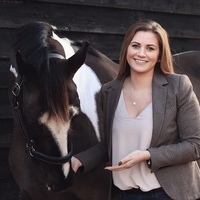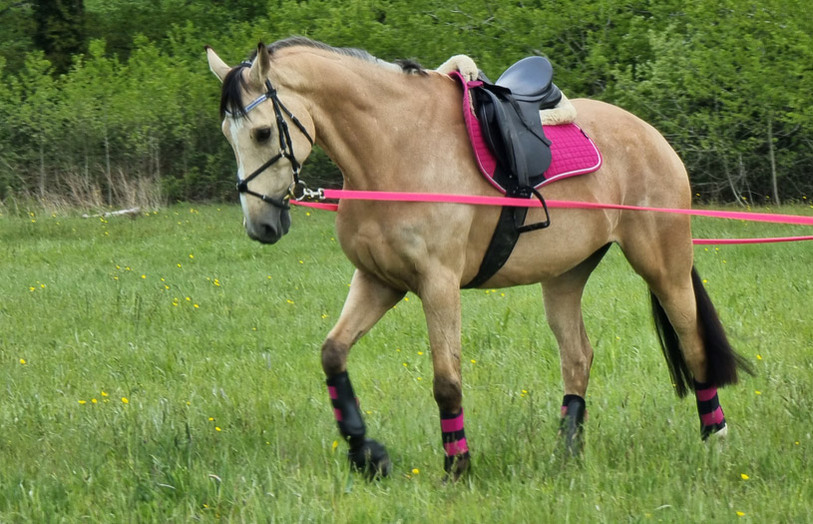
Are You & Your Horse Ready For Bitting Advice? The Steps You Need To Consider First
Equestrian Advice & Guides All Disciplines
Build your business profile for FREE and expose your services to thousands of potential clients!
Create my profile now!
With all of my horses, young or old, I find groundwork is key to their progression and development in training. So today, I’m going to talk about long reining, as I don’t see it being done as much as it should. It isn’t as difficult as you might think, and you can certainly make it fun and enjoyable for both you and your horse. In fact, it’s really beneficial for both rider and horse, regardless of the age or experience level of your horse; you could just be starting the backing process or your horse could be backed and experienced already.
Long reining could be likened to riding from the ground. It involves attaching two lunge lines (or long reins), of equal length, to the horse’s bridle – one line attached at either side via the bit rings, just as you would with regular reins – and then the length of each line is passed through the stirrup (or a loop in the roller) on the same side as each line. The rider/handler holds a lunge line in each hand, just like you would hold a set of reins.
Long reining is about the contact, the feel, and the body position of the horse and the rider/handler. With a young horse, it allows you to focus on the basic principles that you’ll require once you get on board; getting them used to commands (including your voice) and teaching coordination and balance. If your horse is more experienced, then you can use long reining to work on weaker areas and introduce more complex exercises, from leg yielding to piaffe.
Long reining can improve your horse’s way of going and you can set multiple goals for each long reining session. It also helps young horses to accept the contact, as you have contact in both reins, and will help to encourage bend and suppleness in horses of any age.
For young horses, the 2 lines work well when you want to start introducing them to working in a circle – you can create a clearer line of direction for the circle than you can when lunging, and prevent the horse from falling in or out. This can also be effective for the more experienced horse; if you find the horse falls in or out when ridden, it enables you to correct this from the ground.

When you’re riding, it can sometimes be hard to see what you can feel, so long reining is really useful in that you can repeat the exercise on the ground and observe your horse from a different angle and perspective. This helps you to gain a deeper understanding of what it is you’re feeling when you ride.
Another rider/handler benefit of long reining is that it helps to create a stronger bond between horse and rider, and can even increase your confidence and improve your vocal commands, coordination and awareness.
Long reining also allows the horse to exercise without the weight of a rider in the saddle, so it can be incredibly beneficial for rehabilitation, when bringing horses back into work after injury or time off.
Even if a horse is in regular work, doing an exercise without a rider on board can help them perform in a different way, without the interference of a rider using too much leg/hand/weight in the wrong places. For example, this could be used to help teach your horse to be straighter down the centre line without the need for a rider to correct them constantly, so you can reap the benefits when you’re next on board. Plus, you will no longer be restricted to only working on straightness when you’re in the school, now you’ll be able to go out into the fields or even do some long reining out on the roads.
The basic equipment required for long reining is as follows;

If this is the first time you are long reining your horse, it’s best to assume the horse has not been long reined before. Whenever I am introducing a new exercise to the horse, I like to take things slowly and take all possible precautions, such as having another handler to help.
To begin, I like to have a headcollar on underneath the bridle so I can have an extra pair of hands and have a handler leading the horse with a leadrope, while I start building the contact up with the horse from the side. This will give both you and the horse confidence in the contact and what will be asked. The horse will be experiencing new feelings, such as the lunge lines along their shoulders, ribs and quarters, so as the horse settles and once they are calm, I begin to work my way back to behind the horse.
Your position is key to success; you don’t want to be too close to the horse’s back legs – in the kicking zone – but you also don’t want to be too far away or you’ll lose the contact in the long length. Make sure you are also positioned slightly to the side of the horse so that you are not in their blind spot. I like to hold the lunge lines as if they are reins, whilst keeping the spare length coiled so as not to interfere with my movement.

When I am training a horse to long rein, I keep the handler at the horse’s side, leading them while I ask different things from the horse; such as turning, standing and walking away again, changing the rein and trotting. Once the horse understands what’s being asked, I ask the handler to unclip the leadrope and repeat the process while slowly asking the handler to step further away from the horse.
1. I mentioned that I hold the lunge lines like they are reins; this is so I can have an elastic contact, keeping my elbows bent and forearms relaxed.
2. Once the horse is relaxed and moving nicely, I start to use the inside line to act like my leg if I was riding, putting pressure on the side so my horse can start to work leg to hand and bend around the aids as if I was on top.
3. While long reining, you will have the same goals as you do when you’re on the horse; impulsion, suppleness, rhythm, tempo, speed. You want to drive the horse forward enough to engage enough energy to work correctly, but just like riding, you do not want to nag the horse to go forward.
4. To keep your horse motivated, you can mix up the exercise by trying it in different locations, such as in a field or on the road. If your horse is young or spooky, taking them out of the school will help them get used to encountering a variety of things while being handled from the ground.
5. Once the horse is established going on the straight, you can move on to adding in circles while on the long reins. Like lunging, you can play around with the size of the circle and use the whole arena space. You can also do other exercises such as serpentines or shallow loops.
6. Just like any exercise, the warm up and cool down are important. So make sure you cool down with some nice stretches on a longer contact.
If you’re thinking of giving long reining a go, then I recommend practising your technique on an experienced horse first, before doing it with a youngster.

